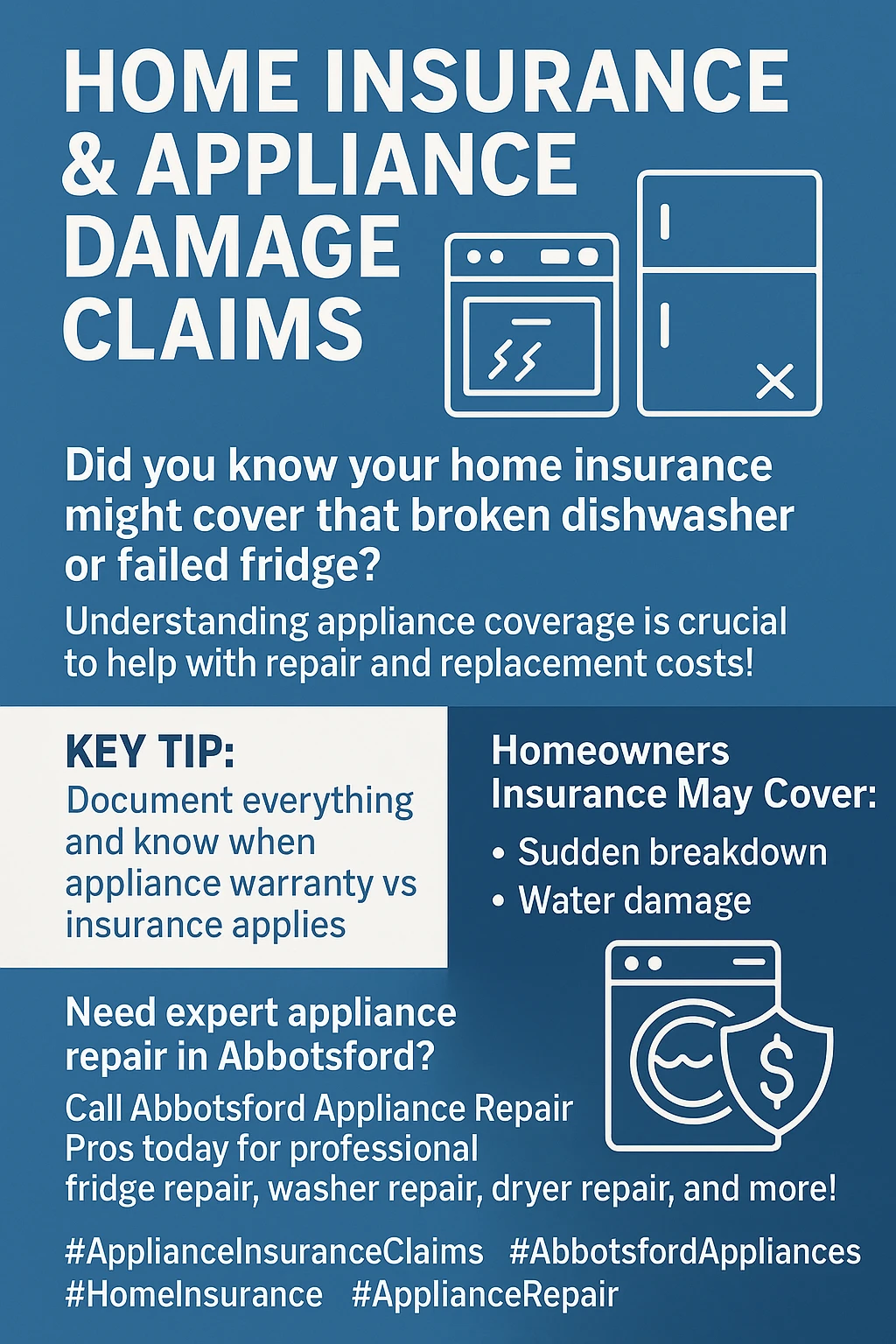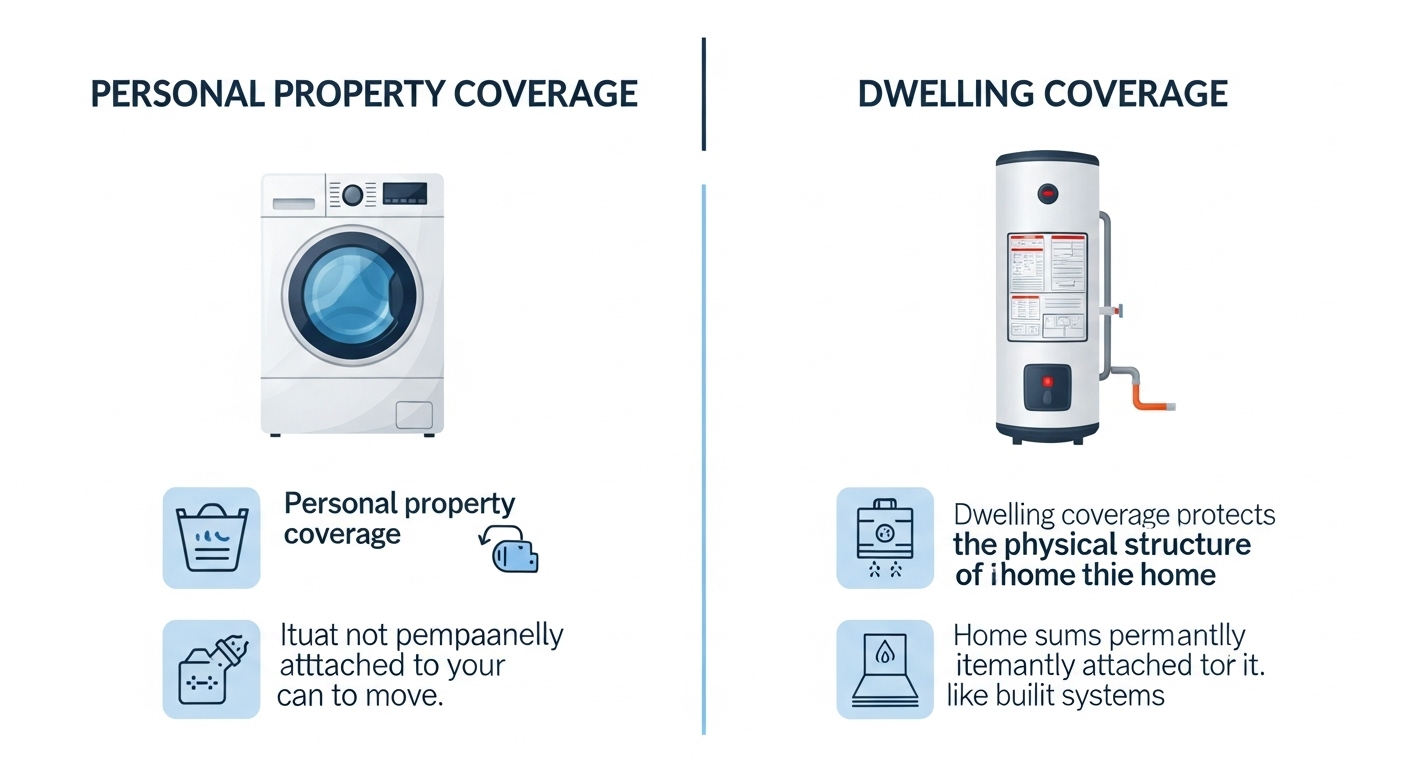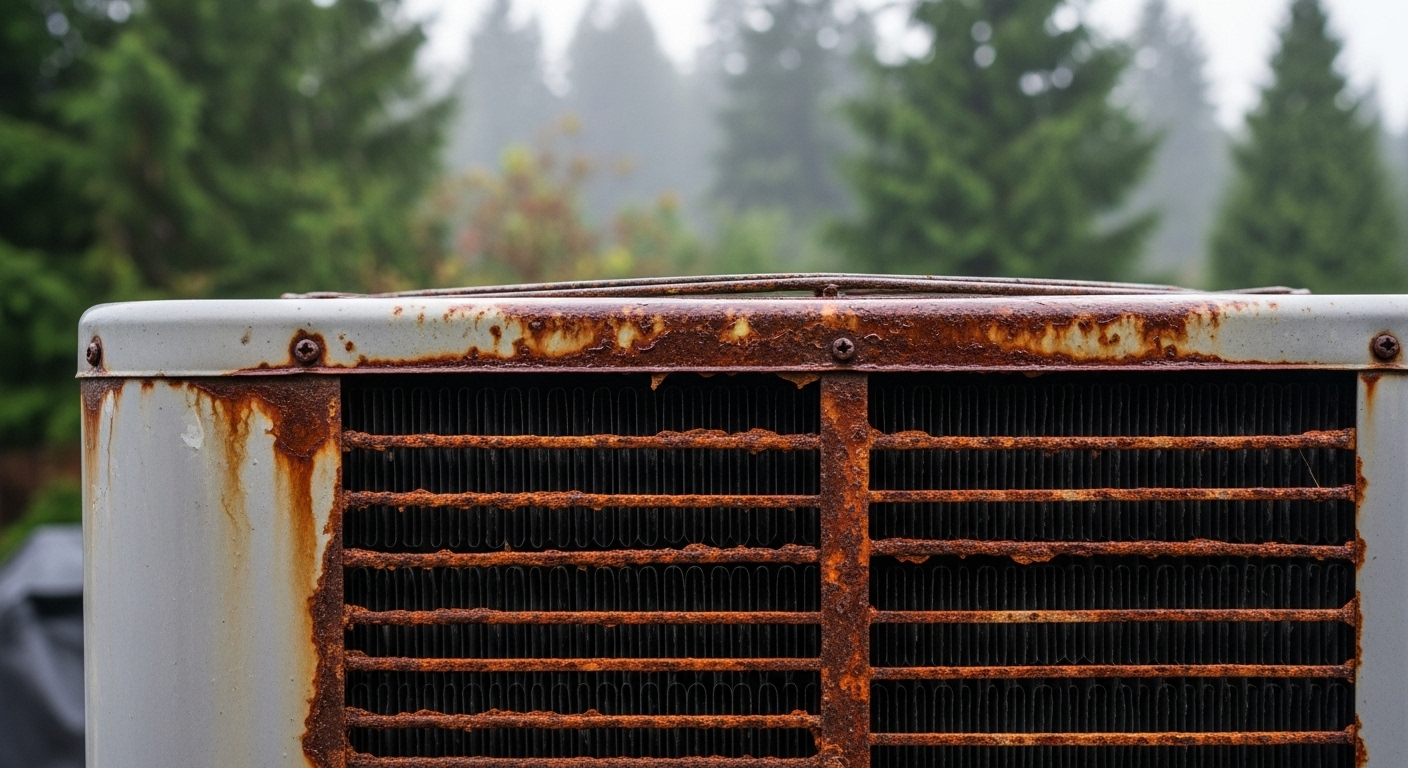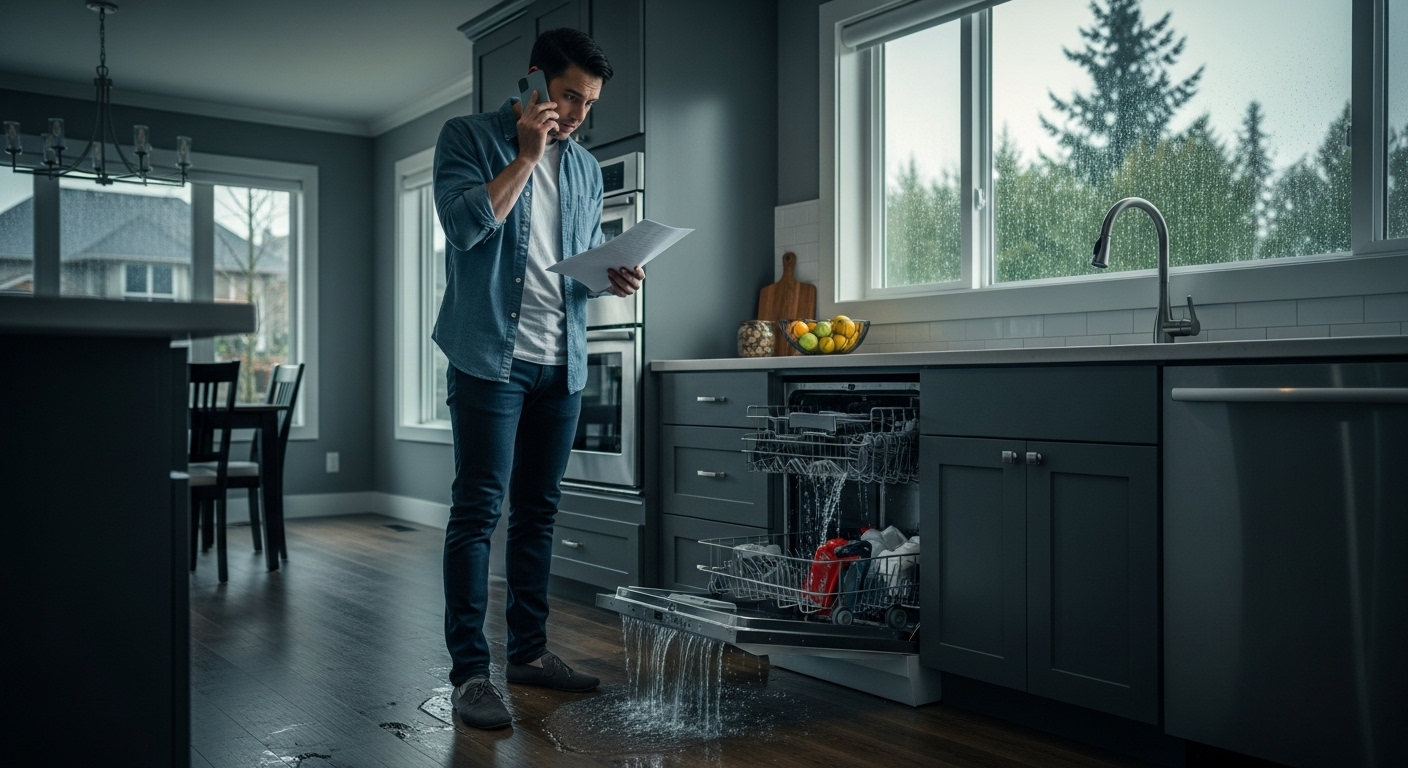Appliance Insurance Claims: What Abbotsford Homeowners Need to Know About Getting Coverage for Repairs and Replacements
Dealing with a broken appliance and wondering if your Abbotsford home insurance will actually cover the damage? You’re not alone – many homeowners discover too late that improper documentation or missed filing deadlines can turn a covered claim into an expensive out-of-pocket repair bill.
Picture this: your three-year-old dishwasher suddenly floods your kitchen during one of Abbotsford’s winter storms, causing water damage to your hardwood floors and cabinets. You think you’re covered, but six months later you’re still fighting with your insurance company over depreciation calculations and coverage limits. Unfortunately, this scenario plays out in Fraser Valley homes more often than you’d think, especially with our region’s unique climate creating appliance challenges that standard insurance policies don’t always address clearly.
The reality is that successful appliance insurance claims require much more than just calling your agent and hoping for the best. From understanding the difference between personal property and dwelling coverage to documenting Abbotsford’s specific climate-related damage patterns, homeowners need a strategic approach to maximize their coverage. What makes our region particularly tricky is our mix of older heritage homes, modern strata regulations, and coastal conditions that create unique damage scenarios insurance adjusters don’t see in other markets.
Whether you’re dealing with humidity-related appliance corrosion, electrical surge damage from BC Hydro fluctuations, or water damage from our aging infrastructure, understanding the claims process can mean the difference between full replacement coverage and a disappointing settlement that leaves you thousands of dollars short. The key is knowing what documentation to gather, when to file, and how to work effectively with adjusters who may not understand Abbotsford’s specific housing and climate challenges.
Key Outtakes:
- Proper documentation within 24 hours of appliance damage significantly increases claim approval rates and settlement amounts
- Abbotsford’s coastal climate creates unique appliance damage patterns requiring specialized documentation for humidity effects and electrical issues
- Home insurance covers appliances through personal property coverage (portable items) or dwelling coverage (built-in systems), with different limits and deductibles
- Understanding depreciation calculations and replacement cost coverage can help homeowners negotiate settlements that reflect Abbotsford’s premium appliance market pricing
- Equipment breakdown coverage fills critical gaps in standard policies by protecting against mechanical failures that normal homeowners insurance excludes

Understanding Home Insurance Coverage for Appliances in Abbotsford

Before you can successfully file an appliance insurance claim in Abbotsford, you need to understand exactly what your home insurance policy covers and how appliances are classified. This isn’t as straightforward as most homeowners assume, especially in our region where the unique housing mix of heritage homes, modern condos, and strata regulations creates coverage complications that don’t exist in other markets. The insurance industry hasn’t exactly kept pace with Abbotsford’s rapid housing evolution, leaving homeowners in a frustrating gray area when appliances fail.
Most Abbotsford home insurance policies classify appliances into two distinct categories that determine your coverage limits and deductibles. Personal property coverage typically applies to portable appliances like refrigerators, washing machines, dryers, and standalone freezers. These items are usually covered for 50-70% of your dwelling coverage amount, which means if you have a $500,000 home, your personal property coverage might cap out at $250,000-$350,000 total. However, this coverage is shared among all your belongings, so appliances compete with furniture, electronics, and clothing for the same coverage pool.
Dwelling coverage, on the other hand, applies to built-in appliances that are considered part of your home’s structure. This includes systems like HVAC units, water heaters, built-in dishwashers, and range hoods that are permanently installed. The good news is that dwelling coverage typically offers higher limits and sometimes lower deductibles than personal property coverage. The challenging part is that insurance companies don’t always agree on which appliances fall into which category, especially in Abbotsford’s older homes where appliances might be semi-built-in or modified to fit unique spaces.
Abbotsford homeowners also need to understand covered perils – the specific types of damage that trigger insurance coverage. The most common covered perils for appliance damage include electrical surges from power fluctuations during our frequent storms, fire damage that affects appliances beyond repair, sudden and accidental water damage from burst pipes or appliance malfunctions, and theft of portable appliances during break-ins. What’s crucial to understand is that normal wear and tear, gradual leaks, or maintenance issues are specifically excluded from coverage, regardless of how expensive the resulting damage might be.
One coverage option that’s becoming increasingly important for Abbotsford homeowners is equipment breakdown coverage. This optional coverage provides protection for mechanical, electrical, or pressurized system breakdowns that wouldn’t otherwise be covered under standard home insurance. For our region’s strata buildings, equipment breakdown coverage is often essential because shared utility systems can create individual unit liability that standard policies don’t address adequately.
The Coastal Climate Factor: How Abbotsford’s Environment Affects Claims

Moving from general coverage to specific regional challenges, Abbotsford’s coastal proximity creates environmental conditions that directly impact how appliances fail and how insurance companies evaluate damage claims. Living in the Fraser Valley comes with beautiful scenery and mild temperatures, but it also means dealing with humidity levels and salt air exposure that can wreak havoc on household appliances in ways that insurance adjusters from drier regions might not fully understand.
Salt air infiltration represents one of the most misunderstood aspects of Abbotsford appliance damage, particularly affecting exterior units like heat pumps, air conditioning systems, and any appliances with exterior venting. This isn’t the kind of damage that shows up immediately – it develops gradually over months or years, creating corrosion patterns that might look like normal wear and tear to adjusters unfamiliar with coastal conditions. When documenting this type of damage, you need to photograph not just the obvious rust or corrosion, but also any unusual buildup of salt residue, deterioration of electrical connections, and performance issues that directly correlate with your appliance’s exposure to coastal air.
Our region’s notorious humidity creates ongoing challenges for appliances designed to manage moisture, and these challenges often fall into insurance company blind spots. Front-loading washing machines, while incredibly popular and energy-efficient, become particularly susceptible to mold and mildew issues in our persistently damp climate. These problems lead to frequent door seal replacements, persistent odor issues, and sometimes complete drum replacement – repairs that can easily cost $800-1,500 but often get classified as “maintenance issues” rather than covered mechanical failures.
The frequent power fluctuations and outages we experience put additional stress on appliance electronics that most other Canadian cities simply don’t deal with to the same degree. Abbotsford’s mix of aging electrical infrastructure in established neighborhoods and rapid development putting strain on the grid creates power quality issues that wreak havoc on sensitive electronic components. Control board failures, digital display problems, and electronic component burnouts occur much more frequently here than in areas with stable, modern power grids.
These failures often fall outside standard warranty coverage if insurance companies decide they’re related to power quality rather than manufacturing defects, making proper documentation of power conditions absolutely essential. Understanding surge protection and how to document electrical damage becomes crucial for Abbotsford homeowners dealing with frequent power issues that can destroy expensive appliances without warning.
Step-by-Step Claims Process for Maximum Approval

Now that we understand the coverage landscape and regional challenges, let’s dive into the actual process of filing appliance insurance claims that get approved rather than denied. The success of your claim often depends entirely on how well you handle the first 24-48 hours after discovering damage, and there are specific steps that dramatically increase your chances of a favorable settlement.
The moment you discover appliance damage, your first priority should be immediate notification to your insurance company, ideally within 24 hours. This notification starts the official claims timeline and demonstrates diligence in reporting, which insurance companies consider when evaluating claim validity. When you call, have specific details ready: when you first noticed the problem, what you think caused the damage, and a preliminary assessment of what’s affected. Don’t guess about causes – stick to facts about what you observed.
Simultaneously with insurance notification, start documenting everything with high-quality photos and videos. For water damage claims, this is especially critical. Photograph the source of the leak, the extent of the water’s spread, and any damaged flooring, cabinets, or personal belongings. Use a ruler or measuring tape to show the depth of standing water and the height of watermarks on walls. For electrical damage, take photos of any visible signs of surge damage like scorch marks on outlets or appliance plugs. Keep a detailed log of every conversation you have with your insurance company, including the date, time, name of the representative you spoke with, and a summary of what was discussed. This log becomes invaluable if there are any discrepancies in your claim later on.
